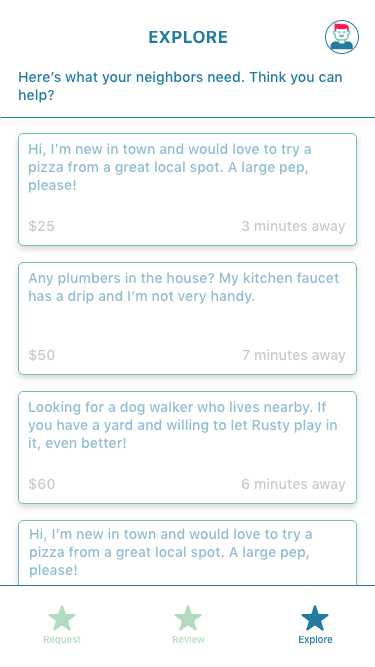CHIMNEY
Residents in major metropolitan areas can get nearly anything they want to be delivered to their homes but they’re becoming increasingly isolated from their neighbors, resulting in a loss of strong community ties and a weakening of the fabric that ties us all together. Chimney is a mobile application that would allow people to continue to enjoy the convenience of modern digital life while enabling them to engage with their neighbors and forge strong local connections. Using Chimney, users could still get the things they need and contract the services they require but instead of interacting with nameless strangers, they’d connect with their neighbors.
Tools
XD, Photoshop
My Roles
Project Manager, Product Designer, UX Designer
Design Process
Chimney was developed by a four-person team over 22 weeks and involved every aspect of product development, from research and design to iterative development and testing cycles.
Research
An initial review of the target space revealed a recent survey that found 50% of those surveyed didn't know their neighbors but 75% believed there was value in knowing them. Further, 78% preferred working with neighbors rather than strangers for simple services. Our thesis strengthened by this, we moved forward with user research.
The Chimney target audience was divided into four discrete groups, based on their unique needs:
1. Apartment/Condominium Residents - Potentially not as accessible to delivery. Live in populated cores near businesses. May not have a car (use public transit).
2. Single-Unit Home Residents - Typically reside with families. Typically have a car.
3. Requesters - Enjoy staying at home and ordering. Comfortable with Technology.
4. Fulfillers - Willing to accept orders. Enjoy completing tasks.
Using these four groups as a foundation, I collected feedback from 25 potential users through surveys and in-person interviews. This allowed me to develop a set of feature priorities and and personas to guide development.
Personas


Solution Scope
Next, the team settled on a scope of features to limit and focus our efforts. Chimney would allow users to request a good or service, along with a price they're willing to pay (if any), and other Chimney users who live within a specific radius of the requester (i.e. "neighbors") would be notified of the request and choose to fulfill it. Further, Chimney would not facilitate fund transfers as this would shift the focus from creating community connections to a transaction-based focus, which is counter to the team's goals. Personal information, like names or addresses, would be private until two parties had agreed to engage in an exchange.
Evolutions
Review


One prominent feature of the final design was the use of a card-style interface to manage active requests. The original design included tabs to differentiate from accepted requests and requests created by the user, but feedback indicated there was some confusion about how to navigate between these areas. Cards were the perfect solution, as queues like color accents and information types presented could do the work of tabs in a more elegant way.
Explore


This design was carried through in the Explore interaction as well, incorporating left-right swiping versus top-bottom, which testing bore out as a much more enjoyable method of browsing.
Prototype
After multiple iterations and rounds of development, testing and feedback, I created a functional prototype the development team used to create a working, coded version of the application.